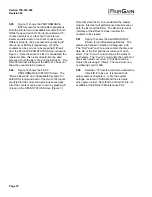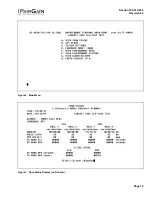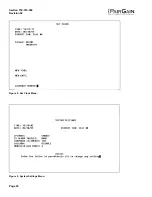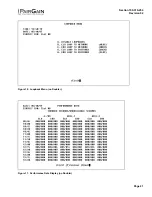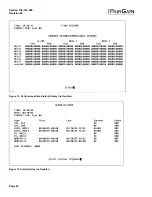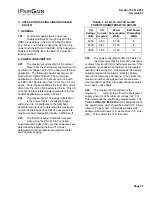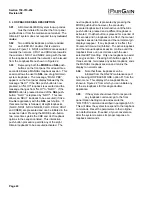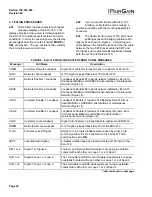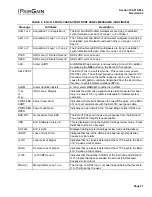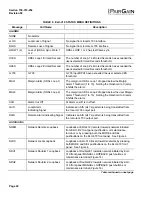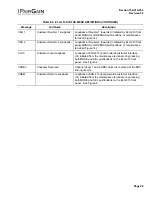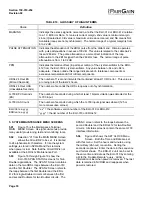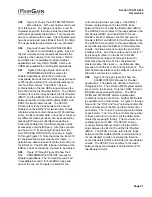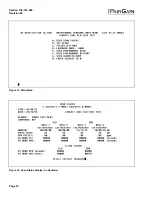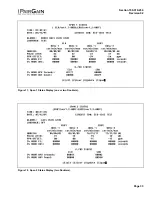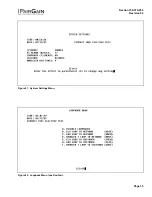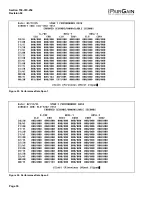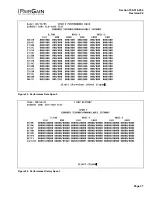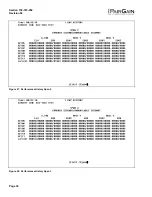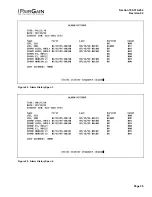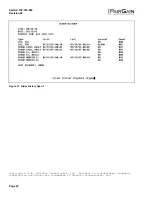
Section 150-319-254
Revision 02
Page 31
5.05
Figure 21 shows the SYSTEM SETTINGS
Menu Screen. All 5 user options can be set
from this screen. To change any option, enter its
character key which is shown inside the parenthesis
within each parameter description. This causes the
screen to refresh with the new. After all parameters
have been selected, press E (Exit) then C (Confirm).
The newly selected parameters are now activated.
5.06
Figure 22 shows the LOOPBACK MENU
Screen for a two-Doubler system. Each of
the four modules can be looped back towards the
network or the customer from this screen. NDU2
and CDU2 are not available for single Doubler
applications and only NLOC, NREM, CLOC and
CREM are available for non-Doubler applications.
5.07
Figure 23 through Figure 26 show the
PERFORMANCE DATA screens for
Doubler applications. Both the Errored and
Unavailable Seconds for both HDSL loops and each
G.703 input are listed at 15-minute intervals over a
four hour time interval. The SPAN 1 Screen
contains data on the two HDSL loops between the
ELU-319 and the first Doubler (EDU1). The SPAN 2
Screen refers to the loops between the first Doubler
(EDU1) and the ERU-412 for one Doubler circuits or
between the first and second Doublers (EDU1 and
EDU2) for two-Doubler circuits. The SPAN 3
Screen refers to the loops between the second
Doubler and the ERU-412 for two-Doubler circuits.
All status screens contain the same G.703 interface
errors. Earlier and later data, in four-hour chunks on
six different screens per span, can be accessed by
pressing P (Previous) or N (Next) respectively.
Performance data from the different spans can be
accessed by entering S (Span). All of the counters
can be set to “0” by pressing C (Clear) from the
ELU-319 SPAN STATUS Screen shown in Figure
16 through Figure 19. Note that since the ELU-319
is considered the master module, this clears
all
performance data screens at both the ELU-319 and
the ERU-412. The RS-232 terminal interface at the
ERU-412 does not allow the counters to be cleared.
5.08
Figure 27 through Figure 30 show the 7-
DAY
PERFORMANCE HISTORY screens for
Doubler applications. The “Errored Seconds” and
“Unavailable Seconds” for both HDSL loops and
each of the two G.703 inputs are listed for the
current and previous seven days. The SPAN 1
Screen contains data on the two HDSL loops
between the ELU-319 and the first Doubler (EDU1).
The SPAN 2 Screen refers to the loops between the
first Doubler (EDU1) and the ERU-412 for one-
Doubler circuits or between the first and second
Doublers (EDU1 and EDU2) for two-Doubler circuits.
The SPAN 3 Screen refers to the loops between the
second Doubler and the ERU-412 for two-Doubler
circuits. All status screens contain the same DS-1
interface errors. All of the counters can be set to “0”
by pressing C (Clear) on the ELU-319 SPAN
STATUS Screen (Figure 16 through Figure 19).
Note that since the ELU-319 is considered the
master module, this clears
all
performance data
screens at both the ELU-319 and the ERU-412. The
RS-232 terminal interface at the HRU-412 does not
allow the counters to be cleared.
5.09
Figure 31 through Figure 33 show the
ALARM HISTORY screens for Doubler
applications. The alarms are defined in Section 4
Paragraph 4.01. The LOS and PWR system alarms
are common to all spans. Only the LOSW, ES and
MARGIN are span specific alarms. The PWR-
OPEN and PWR-SHRT alarms indicate alarm
conditions on the ELU-319 List. Neither PWR alarm
is available on the other spans. In Figure 31 through
Figure 33, the “First” and “Last” columns contain the
time and date stA of the first and last occurrence of
each alarm. The “Current” column shows the status
of each alarm. The “Count” column lists the number
of times each alarm occurred. All the data can be
cleared by pressing C (Clear). The maximum non-
overflowing count is 999. The SPAN 1 Screen
concerns alarms that occurred on the two HDSL
loops between the ELU-319 and the first Doubler
(EDU1). The SPAN 2 Screen refers to the loops
between the first Doubler (EDU1) and the ERU-412
for one-Doubler circuits or between the first and
second Doublers (EDU1 and EDU2) for two-Doubler
circuits. The SPAN 3 Screen refers to the loops
between the second Doubler and the ERU-412 for
two-Doubler circuits.


